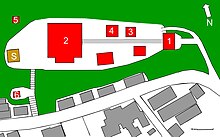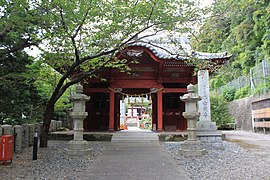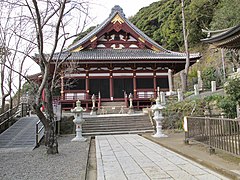Nago-ji
The Nago-ji ( Japanese 那 古寺 ) with the mountain name Fudaraku-san ( 補 陀 洛 山 ) is a temple of the Shingon Buddhism in Tateyama ( Chiba Prefecture ), Japan. In the traditional count it is the 33rd of the 33 temples in the Kantō region and the 1st of the 34 temples in the Awa province .
history
The temple was created according to tradition during the Yōrō era (717-724) by priest Gyōki . In 1703 all buildings of the temple were lost due to an earthquake. The main hall, also called "Kannon Hall", was rebuilt in 1758. The other buildings followed a little later.
The attachment
You enter the temple complex at the foot of the hill through the temple gate, which is designed here as a Niō gate ( 仁王 門 Niō-mon ; 1 in the plan), i.e. as a gate with the two temple guards ( Niō ) to the right and left of the passage. Ahead you can see the main hall ( 本 堂 Hondō , 2), namely the left side, with a staircase to the surrounding gallery. On the way there you pass the " Amida Hall" ( 阿 弥陀 堂 Amida-dō ; 3) and the treasure pagoda ( 多 宝塔 Tahōtō ; 4) of the temple on the right. The signature on the main pillar shows that this pagoda dates from 1761, that an Iseya Jin'emon ( 伊 勢 屋 甚 右衛門 ) was the main sponsor and that local carpenters built it. The main hall and the treasure pagoda are registered as cultural property of the prefecture.
In the vicinity of the temple is the " Daikoku -Halle" ( 大 黒 堂 Daikoku-dō ; 5) and the Benzaiten ( 弁 財 天 ; 6): Daikoku and Benzaiten are two of the seven gods of good fortune , who are also worshiped in Shintō . Finally, the Hiei Shrine ( 日 枝 神社 Hiei-jinja ; S) is on the premises.
Treasures of the temple
The "1000-armed Kannon" ( 銅 造 千手 観 音 立 像 Dozō senju Kannon ritsuzō ) made of copper is registered as an important cultural asset of Japan . The Kannon is 1.05 m high, the arms were manufactured and attached separately from the body. The symbols der 胤 時 can be read at the point where the parts are joined. This should mean the grandson of Chiba Tsunetane ( 千葉 常 胤 ; 1118–1201), which means that the figure can be dated to the Kamakura period .
Among the treasures are copies of the Kanseon Sutra ( 観 世 音 経 ), the Kujakuōju Sutra ( 孔雀王 呪 経 ), a Chinese hanging scroll made of silk from 1361 with an illustrated sutras text ( 繡 字 法 華 経 普 門 品 Jūji Hokekyō fumonbon ) and a seated Amida sculpture ( 木造 阿 弥陀 如 来 座像 Mokuzō Amida-nyorai zazō ) from the beginning of the Kamakura period. All of them are registered as cultural property of the prefecture, but are not open to the public.
photos
literature
- Chiba-ken kotogakko Kyoiku kenkyukai rekishi bukai (Ed.): Nago-ji . In: Chiba-ken no rekishi sampo. Yamakawa Shuppan, 2006. ISBN 978-4-634-24612-6 . Pp. 278, 279.
Web links
Coordinates: 35 ° 1 '32 " N , 139 ° 51' 28.7" E




